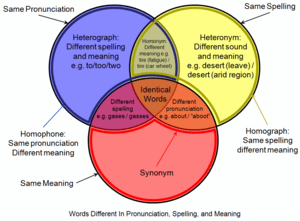Homograph facts for kids

A homograph is a cool word that has the same spelling as another word, but a different meaning. Sometimes, these words are even pronounced differently! It's like having two different words that look exactly the same on paper.
Contents
What are Homographs?
Homographs come from Greek words. "Homo" means "same," and "graph" means "write." So, a homograph literally means "same writing." These words can be a bit tricky because you need to look at the rest of the sentence to understand which meaning is being used. It's all about context!
Examples of Homographs
Let's look at some common homographs to see how they work:
- Polish (pronounced POH-lish): This means someone from Poland, a country in Europe.
- polish (pronounced POL-ish): This means to make something shiny, like polishing your shoes.
Here are more examples:
- Dove (pronounced DUHV): This is a type of bird, often a symbol of peace.
- dove (pronounced DOAV): This is the past tense of "to dive," meaning to jump headfirst into water.
- Present (pronounced PREZ-ent): This can mean a gift, like a birthday present.
- present (pronounced pre-ZENT): This means to show or give something, like presenting an award.
- present (pronounced PREZ-ent): This can also mean to be somewhere, like "I am present in class."
- Fine (meaning feeling well): "I feel fine today."
- fine (meaning a penalty): "You might get a fine for illegal parking."
Why are Homographs Tricky?
Homographs can sometimes cause confusion because their identical spelling can make you think they are the same word. However, their different meanings and sometimes different pronunciations mean you have to pay close attention to the sentence they are in. This is why understanding the context is so important when you read or listen to English.
Homographs, Homophones, and Homonyms
It's easy to mix up homographs with other similar word groups. Let's clear things up:
- Homographs: Same spelling, different meaning, sometimes different pronunciation (like "bow" for a knot and "bow" for a weapon).
- Homophones: Same pronunciation, different spelling, different meaning (like "to," "too," and "two").
- Homonyms: This is a broader term that can mean either homographs or homophones. Sometimes, it refers to words that have both the same spelling AND pronunciation but different meanings (like "bat" for a flying animal and "bat" for a baseball tool).
Understanding these different types of words helps you become a better reader and writer!

